Adam Yamey's Blog: YAMEY, page 64
January 15, 2024
Blooms beneath a bridge in the city of Calcutta
OVERLOOKED BY THE MIGHTY Howrah Bridge and straggling alongside the left bank of the Hooghly River – a stretch of the Ganges – you will find the colourful Mullick Ghat flower market. The best way to enter this busy marketplace is by descending a staircase at the southeast corner of the Howrah Bridge (completed 1943). As you go down the stairs, you will have to step aside to make way for men carrying enormous, heavy loads on their heads. Many of them make use of the stair rails to support themselves while they climb.
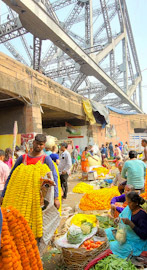
Part of the flower market (next to the railway track) is in the open air. The rest of it – the part nearest to the river – is under cover. Narrow, muddy passages run between the numerous stalls selling whole flowers, flower heads, individual flower parts, and petals. Also, flower garlands and other floral decorations are aplenty. A steady stream of people hurry in all directions along these paths. Many of them are carrying heavy head loads. Occasionally, they dump the head loads (containing floral items) at one stall or another. To an outsider, like me, the place seems like a chaotic but highly colourful environment. It is probably not as crazy as it seems, but highly organised.
The flower market was established along this part of the Hooghly during or before the 19th century (https://www.telegraphindia.com/my-kolkata/places/a-visit-to-mullick-ghat-flower-market-one-of-asias-largest-under-the-howrah-bridge-in-kolkata/cid/1892065). The ghat was built in 1855 by Rammohan Mullick in honour of his father Nimai Charan Mullick. It was constructed on the land where the old Noyaner Ghat had stood. The older landing stage had been made by Noyanchand Mullick in 1793.
The Mullick Ghat stands next to the Jagganath Ghat, which was constructed in 1760. Both ghats were important because they were used by pilgrims embarking on ships to transport them to the holy site at Puri in Orissa. Although it is not known for certain why the flower market was established beside these ghats, it is not unlikely that it was connected to the embarkation places for the pilgrims. And flowers play an important role in Hindu rituals.
Even though the market seemed extremely busy to me, it is apparently in decline. This was in no little way connected with the recent covid19 pandemic. If what I saw is a somewhat diminished version of the market, I can barely imagine what it must have been like a few years ago. Providing you are not allergic to pollen or crowds, a visit to the flower market is an exciting and beautiful experience.
January 14, 2024
From the Ganges to the shore and then back into the river
THE CERAMIC ARTIST, our friend Falguni Bhatt, works in Calcutta. While visiting her studio, she suggested that we visit Kumartuli in north Calcutta. Close to the Hooghly River – part of the Ganges – this district of the city is a warren of narrow lanes lined with the workshops of craftsmen who make Hindu idols out of the grey clay collected from the shores of the Ganges. We went there and were amazed by the huge amount of creative activity that confronted us.
Mounds of damp dark grey clay are carried on the heads of porters to the workshops. Others carry bundles of straw to the artisans. The straw is used to make armatures – these are shaped roughly like the finished idols. A completed armature, which can sometimes include supporting metal rods, looks sufficiently like the idol being created.
Clay is applied to the straw armatures. Gradually, the straw is hidden by the clay. The surface of the clay is either smoothed to resemble fine skin and/or inscribed to create bodily details – for example finger nails and the creases on the palms of hands or facial details or clothing and footwear. Creatures and objects associated with the depicted deity – for example, veenas and snakes – are created in the same way, starting with straw armatures.
The completed idols, which are frequently very detailed and of complex shapes, are left to dry and harden. The clay idols are not fired in a kiln.
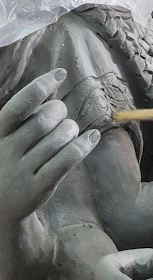 Detailing on a clay idol
Detailing on a clay idolLater, the idols are painted according to tradition, and then decorated with elaborate costumes and jewellery. The jewellery is made from hand cut cardboard often with sequins and mirrors applied. A small section of Kumartuli is dedicated to workshops creating these intricate, attractive ornaments.
Each of the clay idols is an exquisite work of art. Each of them displays evidence of the highly skilled workmanship that created them. They rival the superb ancient Hindu stone carvings that can be found carefully displayed and conserved in museums. Yet, each of these clay masterpieces is destined to have but a very short life.
The idols are created in Kumartuli for use in important Hindu festivals such as Durga Puja, Kali Puja, and Saraswati Puja. We saw idols being prepared for the last mentioned. Most of the idols being created include the stringed musical instrument played by Saraswati – the veena. Her puja is to be held next in February 2024.
During these ceremonies, the carefully crafted idols – fully painted and decorated with elaborate hand made ornaments – are dropped into the Ganges. When I expressed my surprise at hearing about this, Falguni said something like:
“Life is transient.”
January 13, 2024
Rabindranath Tagore, blood, and coffee in Calcutta
THERE IS A BRANCH of the India Coffee House chain in College Street, Calcutta. Housed on the first and second floors of Albert Hall (built 1876 in memory of Victoria’s Prince Consort), it is located in the midst of a vast bazaar specialising in bookselling – mainly textbooks and technical manuals. Soon after it was opened, the coffee house within Albert Hall became a centre of anti-British agitation.
The first floor serving area – many chairs and tables – is overlooked by two huge portraits. One photograph depicts Rabindranath Tagore as a young man and next to this, there is another of the poet and writer Kazi Nazrul Islam. Other smaller painted portraits line the walls of the café. Waiters wearing pugrees busily wandered around taking orders and delivering food and drinks – mostly coffee.
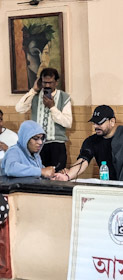
This ninth of January (2024) was a special day when an annual blood donation camp was held in memory of the Bengali footballer Sailendra Nath Manna (1924-2012). It was, as we discovered today, being carried out on the second floor gallery overlooking the serving area of the College Street India Coffee House.
Loudspeakers within the coffee house and in the streets surrounding it were exhorting people to come and donate some blood. A steady stream of volunteers climbed the staircase to the second floor. One of the officials, who was having coffee at a table near us, suggested we took a look upstairs.
The gallery was full of people. Chairs lined the walls. Donors were sitting in these with catheters in their veins. Several medics were wandering about with stethoscopes around their necks. Those who had donated blood were given packages contains bottled water and snacks. There were a few folding beds ready for anyone who fainted or collapsed during or after they had given blood, but these were unoccupied. Despite the seriousness of the purpose of the occasion, the blood donation camp seemed more like a joyous fair or party than a clinical situation.
We had come to College Street to enjoy the historic ambience of the old coffee house. Little had we expected to come acros a blood donation festival within it.
January 12, 2024
A bowler with only one leg in a park in Calcutta
WHEN I TRAVEL, the things that fascinate me most are not listed in any travel guidebooks. It is chance glimpses of everyday life that interest and delight me most.
This morning (9th of January 2024), we took a morning walk on Calcutta’s Maidan – a vast green space running along the western edge of the heart of the city. After entering the area from Park Street, we walked past a tall statue of Jawaharlal Nehru and came across a large pond, where a few people were bathing.
We walked along the path near to the pool, and met a flock of goats being herded along it towards us. Nearby in a large field, groups of school children were doing drill, marching on the spot, shouting “left, right, left, …”. A boy nearby was beating time on a drum. Beyond the children, there was another flock of goats. Looking away from them, we could see tall buildings through the dusty, hazy sunlight.
We followed various paths in a northerly direction, and came across a fenced in compound where we saw military cadets being taught outdoors. One of their teachers stood at a portable lectern upon which he had his lecture notes. Next, we saw a cricket match. We watched for a few moments, but nothing exciting happened.
Heading further north, we passed a huge open space fringed with various kinds of trees, including palms. Near the northern edge of the field, we came across a cricket practicing net. What we saw there was quite unexpected.
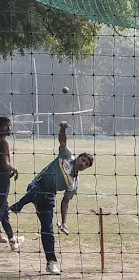 The one-legged bowler in action
The one-legged bowler in actionThere was nothing unusual about the batsman in the net. Padded up, he faced the bowlers, and whacked the balls bowled at him. There were two bowlers, who took turns to pitch the ball at the batsman.
One of the bowlers was an invalid. One of his legs had been amputated at knee level, or maybe just above. He supported himself on his one intact leg and a stout pole that he used as a crutch. Each time he bowled, the ball flew fast and was aimed accurately. Despite his considerable impediment, he was a formidable bowler. We watched spellbound as he bowled over and over again. If one had been unable to see his legs and his support, one would never have guessed that he had a serious physical impairment. It was life enhancing seeing this man making the most of life.
After watching the one-legged bowler, we hailed a taxi to carry us up to College Street, where we experienced another event that you would not find in any guidebook, but more about this in a future essay.
January 11, 2024
A Parsi fire temple and a Russian in a street in Calcutta
ANYONE WHO KNOWS Calcutta well might wonder what made us stroll along Ezra Street. We had just left St Andrews Kirk (completed in 1818), where we heard the start of a Sunday service in Nepali, when I realised we were not far from Ezra Street. The Street is named after a trader David Joseph Ezra (died 1882) of Baghdadi Jewish heritage. But that is not why we visited the street.
My wife’s sister-in-law was brought up in number 48 Ezra Street in a house that my wife remembered as having been a glorious, picturesque old building. We wanted to see what, if anything, was left of the residence.
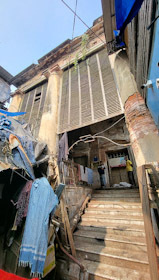 The ruined agiari
The ruined agiariOn our way along the street, we spotted a board that read “Rustomjee Cowasjee Church”. We entered the building and saw nothing that looked remotely like a Parsi fire temple (agiari). Instead, we found ourselves in a series of dimly lit chandelier and fancy lamp showrooms. We asked about the “Parsi Church”, and were shown the way to it. By the way, it seems that if a place of worship is neither a ‘mandir’ nor a ‘masjid’, then it is described by locals in Calcutta as a ‘church’ – be it a church, a synagogue, or an agiari.
The agiari behind the lamp shops is no longer in use. It is falling to pieces and unsafe to enter. It stands behind a verandah whose roof is supported by sturdy pillars with Doric capitals. It must have been magnificent in its heyday. We saw two plaques – one in English, and the other in Gujarati. Although it is in a poor condition, Kolkata Heritage has listed it as a ‘Grade 1’ monument. It was built in about 1839.
Number 48 Ezra Street has been demolished and replaced by an unattractive new building. Outside its main entrance, there is a memorial plaque in English. It records that the Russian adventurer, linguist, musician, writer, and translator, Gerasim Stepanovich Lebedev (1749-1817), opened a theatre on the site of number 37 Ezra Street, which faces number 48. His theatre was the first in Calcutta to employ Bengali actors and actresses. The first performance was in November 1795.
According to Wikipedia:
“Lebedev lived in Calcutta (now Kolkata), then the capital of British India, for about ten years. During his stay, he started to learn Hindi, Sanskrit and Bengali from a local schoolteacher named Golokhnath Das. In exchange, Lebedev had to teach Das violin and European music. With the support of a Russian doctor, then practicing in Calcutta, he was soon established as a musician. Tickets for his musical programmes were priced at Rs. 12. Lebedev was the first person to use Indian tunes on Western musical instruments”
The British colonial authorities became unhappy with Lebedev being in India, and expelled him in 1797. Eventually, he returned to Russia, where he was employed by the Russian Foreign Ministry. But before reaching his native land, he stopped off in London, where he published his “Grammar of the Pure and Mixed East Indian Languages”.
Although we saw nothing of the house in which my wife’s sister-in-law lived during her childhood, our stroll along Ezra Street allowed us to discover the well hidden remains of a Parsi agiari as well as introducing us to the Russian indolgist, GS Lebedev.
January 10, 2024
My trip from Bangalore to Calcutta began with a bang
OCCASIONALLY, I HAVE A YEARNING for ‘fast food’ – low taste, I know! While waiting at Bangalore’s Airport (terminal 1) for a flight to Calcutta, I felt the urge for a junk food snack, and headed for the KFC outlet in the departure lounge. I placed my order,and was asked to wait for 5 minutes – so much for so-called fast food.
I noticed that the foodstall was right next to a bookstall, run by the Relay company. With my KFC receipt in one hand I hurried towards a glass door that led into the shop. Either it was locked or I misjudged its position. Regardless of the reason, my forehead hit the glass door with great force. The glass remained intact, but not I.
I cursed loudly, and headed for another entrance to the bookshop. As I entered the shop, I touched my forehead and found my fingers reddened with blood. The charming young shop assistants, seeing me and my wound, found a stool and a first aid box, and began stemming the bleeding. With copious amounts of Dettol and Povidone Iodine solution, they cleaned me and my wound. They were very attentive and concerned about me. I was touched and impressed by their gentle and efficient care.
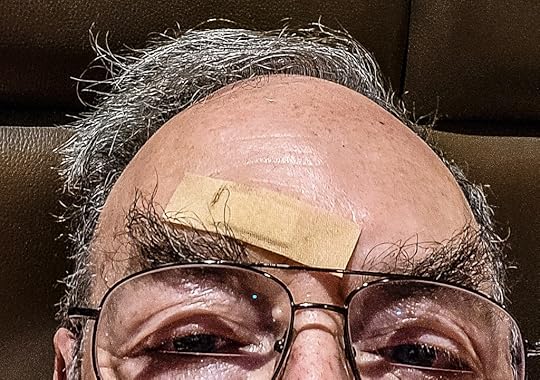 A few days after the accident, with a smaller plaster
A few days after the accident, with a smaller plasterWhen an enormous elastoplast had been applied and I had assured them that I was feeling OK, I returned to KFC, clutching my bloodstained receipt. I carried my meal back to where we were sitting, and tried to reassure my wife that things were not as bad as they looked. Then, I consumed my delicious chicken offering, which the KFC staff had kindly kept warm during my long absence from their stall.
After about 30 minutes, the manager of the Relay stall came up to me to check that I was alright. Then, he took a photograph of my boarding pass. Incidentally, whilst his staff were treating me, they also photographed me and my wound.
The flight took off only 30 minutes late, and I have been enjoying Calcutta since we arrived. I can truly say my trip to West Bengal began with a bang.
January 9, 2024
Road reversal in central Calcutta
BETWEEN 8 AM AND 1 PM, traffic flows one way – from south east to northwest – along Calcutta’s Park Street. After 1 pm, traffic on this important thoroughfare flows one way but from northwest to southeast.
Park Street is one of several main roads in Calcutta on which the traffic flows in one direction until 1 pm,and then in the opposite direction from this time until 8am. It has long puzzled us as to what happens during the period when the direction reverses on these one way streets. Today, we discovered the answer.
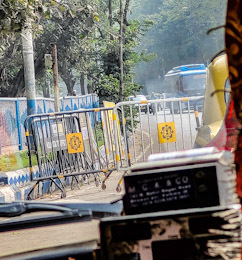 The barrier was removed at 1257 pm
The barrier was removed at 1257 pmWe were in a taxi at about 1250 pm, travelling east towards the start of Park Street. Some distance away from this point, there was a barrier preventing us and other vehicles from continuing towards Park Street. Our taxi and many other vehicles came to a halt at this barrier. Meanwhile, traffic coming towards us gradually diminished in volume to almost nothing.
At about 3 minutes to 1 pm, a traffic police officer slid away the barriers, and we began proceeding towards Park Street. Ours was one of the first cars to be travelling down Park Street from northwest to southeast.
Although I have visited many cities, it is only in Calcutta that I have seen this system of road reversal.
January 8, 2024
Feeding the spirit of the deceased by the River Ganges in Calcutta
WHILE WALKING ALONG the well-tended riverside path that runs alongside the Ganges (Ganga) in Calcutta, we reached the Gwalior Monument – a tall tower overlooking the river. Around this edifice, which was built by the British in 1847, we saw something we had never seen before.
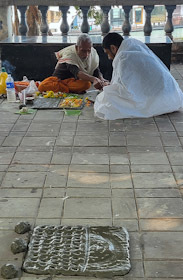
A craftsman was shaping the stiff dark grey mud from the holy Ganges into rectangular slabs with numerous small regular depressions. The finished product looked a bit like an oversized old fashioned Casio calculator. There were quite a few of these to be seen on the flat ground surrounding the monument.
Small groups of men, often with shaven heads, congregated around these mud slabs. The men were chanting prayers and placing grains of rice, sweets,and other food substances into the depressions in the slabs. We asked a bystander what was going on, and he explained it to us in perfect English.
The groups of men were performing ‘shraddha’ on the eleventh day following the death of a family member. Our informant was also attending a shraddha being held because of the recent death of a friend or relative. The son of the deceased was performing the shraddha puja. I have read that it is very important for Hindu couples to have a son because only a son can do shraddha for his parents
On the eleventh day following death, the spirit (atma) of the dead person is still in contact with his or her loved ones. The food being placed on the mud slabs will not, of course, be physically touched by the spirit, but it is believed that it will sustain him or her on the next stage of its eternal journey. A similar shraddha is performed on the first death anniversary and, sometimes, at other times.
Our informant told us that he was not entirely clear about the deep significance of shraddha, but he was happy to believe in its necessity. It was, he felt, an important part of the passage of life.
The eleventh day and one year ceremonies are observed by many Hindus, but until today, neither my wife nor I had ever come across these mud thalis for feeding the spirit of the deceased.
A year after my father-in-law died, there was a special ceremony in which I played an active role, but it was completely different from what we saw next to the Gwalior Monument.
January 7, 2024
Perfect aim in a pharmacy shop in Calcutta
I HAVE BEEN TO many shoe shops in India. Some of these have the store room above the showroom. The ceiling of such showrooms has a hatch through which pairs of shoes can be thrown to the salesmen waiting below. The salesman asks for a particular shoe in a specific size, and someone in the store room drops the pair through the hatch. The shoes are caught by the salesman. Until yesterday, the 4th of January 2024, I had never seen such a system in shops other than those selling footwear.
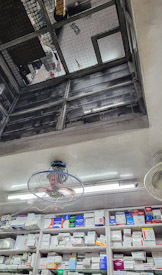 The hatch in the ceiling of the pharmacy
The hatch in the ceiling of the pharmacy Yesterday, we entered a chemist shop (a pharmacy) close to Calcutta’s New Market (SS Hogg Market). The walls were lined with shelves from floor to ceiling. These shelves were filled with boxes of medicines on what seemed like considerable disarray, although I feel sure that there must have been some organisation of the products. There were 5 or 6 men serving customers from behind the shop’s counters.
Like the shoe shops described above, the chemist shop had a hatch in the ceiling. The shop’s stock room was on the floor above the sale room. At frequent intervals, the salesmen yelled names of medicines, ointments, and so on. Somebody in the room above hurled the desired product through the small ceiling hatch. The product was aimed accurately at the salesman who asked for it. Different products kept dropping from the ceiling and being caught by the salesman who had shouted up for it. Whoever it was that was dropping the medications must have recognised the voice of the person who requested it. In addition, the person dropping the products must have had an extremely good aim. He (or she) would make a good cricket player. And the salesmen below never dropped a catch.
Having seen this amazing pharmacy, I have now poked my head into a few others, but none operated this remarkable aerial delivery system. For me, seeing things like that pharmacy near New Market is what makes India seem so wonderful.
January 6, 2024
Birds on a wire: an old question
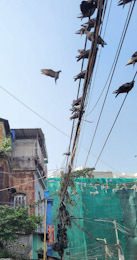 Central Calcutta
Central Calcutta There were twenty six birds perched on a wire.
The farmer shoots one.
How many are left?



